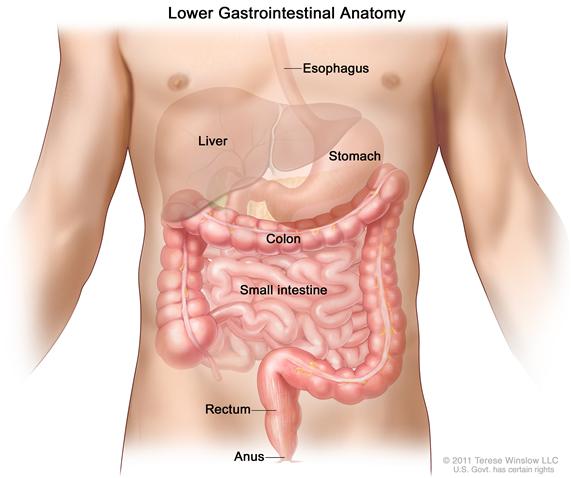General Information About Anal Cancer
Key Points for This Section
- Anal cancer is a disease in which malignant (cancer) cells form in the tissues of the anus.
- Being infected with the human papillomavirus (HPV) can affect the risk of developing anal cancer.
- Possible signs of anal cancer include bleeding from the anus or rectum or a lump near the anus.
- Tests that examine the rectum and anus are used to detect (find) and diagnose anal cancer.
- Certain factors affect the prognosis (chance of recovery) and treatment options.
Anal cancer is a disease in which malignant (cancer) cells form in the tissues of the anus.
The anus is the end of the large intestine, below the rectum, through which stool (solid waste) leaves the body. The anus is formed partly from the outer, skin layers of the body and partly from the intestine. Two ring-like muscles, called sphincter muscles, open and close the anal opening to let stool pass out of the body. The anal canal, the part of the anus between the rectum and the anal opening, is about 1½ inches long.
The skin around the outside of the anus is called the perianal area. Tumors in this area are skin tumors, not anal cancer.
Being infected with the human papillomavirus (HPV) can affect the risk of developing anal cancer.
Risk factors include the following:
- Being older than 50 years.
- Being infected with human papillomavirus (HPV).
- Having many sexual partners.
- Having receptive anal intercourse (anal sex).
- Frequent anal redness, swelling, and soreness.
- Having anal fistulas (abnormal openings).
- Smoking cigarettes.
Possible signs of anal cancer include bleeding from the anus or rectum or a lump near the anus.
These and other symptoms may be caused by anal cancer. Other conditions may cause the same symptoms. A doctor should be consulted if any of the following problems occur:
- Bleeding from the anus or rectum.
- Pain or pressure in the area around the anus.
- Itching or discharge from the anus.
- A lump near the anus.
- A change in bowel habits.
Tests that examine the rectum and anus are used to detect (find) and diagnose anal cancer.
The following tests and procedures may be used:
- Physical exam and history: An exam of the body to check general signs of health, including checking for signs of disease, such as lumps or anything else that seems unusual. A history of the patient’s health habits and past illnesses and treatments will also be taken.
- Digital rectal examination (DRE): An exam of the anus and rectum. The doctor or nurse inserts a lubricated, gloved finger into the lower part of the rectum to feel for lumps or anything else that seems unusual.
- Anoscopy: An exam of the anus and lower rectum using a short, lighted tube called an anoscope.
- Proctoscopy: An exam of the rectum using a short, lighted tube called a proctoscope.
- Endo-anal or endorectal ultrasound: A procedure in which an ultrasound transducer (probe) is inserted into the anus or rectum and used to bounce high-energy sound waves (ultrasound) off internal tissues or organs and make echoes. The echoes form a picture of body tissues called a sonogram.
- Biopsy: The removal of cells or tissues so they can be viewed under a microscope by a pathologist to check for signs of cancer. If an abnormal area is seen during the anoscopy, a biopsy may be done at that time.
Certain factors affect the prognosis (chance of recovery) and treatment options.
The prognosis (chance of recovery) depends on the following:
- The size of the tumor.
- Where the tumor is in the anus.
- Whether the cancer has spread to the lymph nodes.
The treatment options depend on the following:
- The stage of the cancer.
- Where the tumor is in the anus.
- Whether the patient has human immunodeficiency virus (HIV).
- Whether cancer remains after initial treatment or has recurred.



 Back to Top
Back to Top